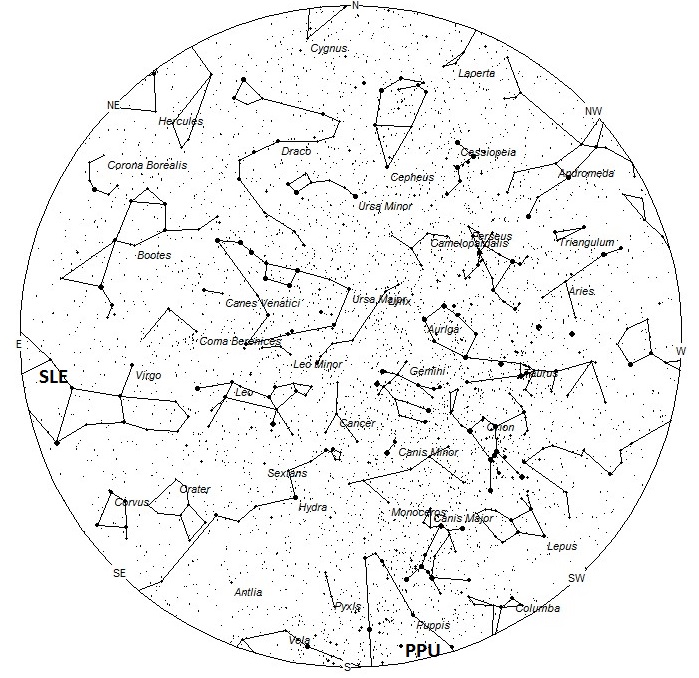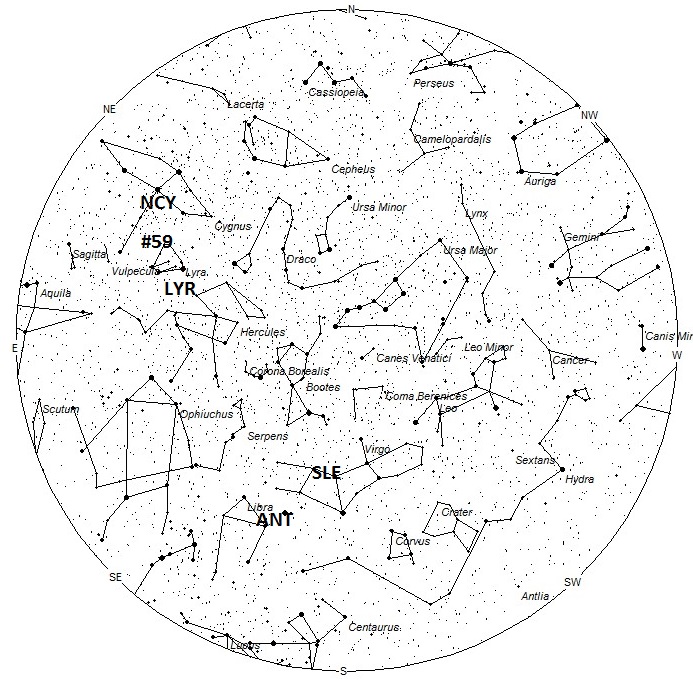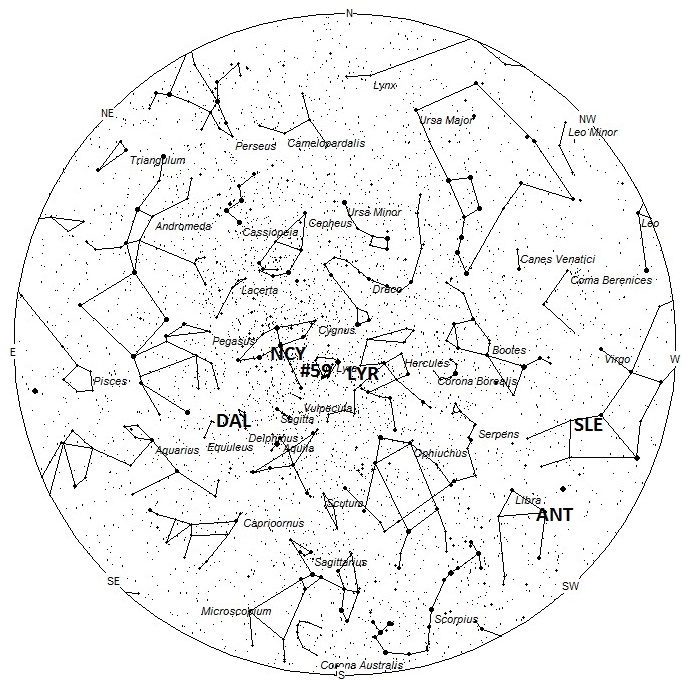During this period the moon reaches its first quarter phase on Wednesday April 17th. At this time the moon is located ninety degrees east of the sun and sets near 0100 local daylight time (LDT). This weekend the waxing crescent moon will set during the late evening hours and will not cause any problems for meteor observing. The estimated total hourly meteor rates for evening observers this week is near three as seen from the northern hemisphere and four as seen from south of the equator. For morning observers the estimated total hourly rates should be near ten from the mid-northern hemisphere and fifteen from the mid-southern hemisphere. The actual rates will also depend on factors such as personal light and motion perception, local weather conditions, alertness and experience in watching meteor activity.
The radiant (the area of the sky where meteors appear to shoot from) positions and rates listed below are exact for Saturday night/Sunday morning April 13/14. These positions do not change greatly day to day so the listed coordinates may be used during this entire period. Most star atlases (available at science stores and planetariums) will provide maps with grid lines of the celestial coordinates so that you may find out exactly where these positions are located in the sky. A planisphere or computer planetarium program is also useful in showing the sky at any time of night on any date of the year. Activity from each radiant is best seen when it is positioned highest in the sky, either due north or south along the meridian, depending on your latitude. It must be remembered that meteor activity is rarely seen at the radiant position. Rather they shoot outwards from the radiant so it is best to center your field of view so that the radiant lies at the edge and not the center. Viewing there will allow you to easily trace the path of each meteor back to the radiant (if it is a shower member) or in another direction if it is a sporadic. Meteor activity is not seen from radiants that are located below the horizon. The positions below are listed in a west to east manner in order of right ascension (celestial longitude). The positions listed first are located further west therefore are accessible earlier in the night while those listed further down the list rise later in the night.
The following showers are expected to be active this week:
Activity from the Pi Puppids (PPU) begins this week from a radiant located at 07:04 (106) -44. This area of the sky is located central Puppis, five degrees southwest of the third magnitude star Sigma Puppis. This area of the sky is best seen as soon as it becomes dark during the early evening hours. No matter your location, rates will be low, far less than one per hour this early in the activity curve. Observers located in the southern hemisphere have a much better view of this activity as the radiant lies higher in their evening sky. At 18km/sec. the Pi Puppids would produce meteors of very slow velocity.
The Sigma Leonids A (SLE) is the first of two branches of this shower. This shower was first noticed by Terentjeva (1990) in her analysis of 554 fireball orbits. This particular branch is active from April 8-16, with maximum activity occurring on the evening of the 10th. The radiant is currently located near 13:20 (200) +04. This position actually lies in central Virgo (not Leo), five degrees east of the third magnitude star Auva (Delta Virginis). The radiant is best placed near 0100 when it lies highest above the horizon. This shower is currently the strongest in the sky, producing an average of two shower members per hour while the radiant is high in the sky. This shower can be seen equally well from both hemispheres and may be partially responsible for the April fireballs. At 22km/sec. this shower would produce meteors of slow velocity.
The second branch (B) of the Sigma Leonids (SLE) becomes active on April 18th and lasts until the 26th. Maximum activity is not until April 20th. On the 18th, the position of this radiant lies at 13:28 (202) +07, which also places it central Virgo, seven degrees northeast of the third magnitude star Auva (Delta Virginis). The radiant is best placed near 0100 when it lies highest above the horizon. At 20km/sec. this shower would produce meteors of slow velocity.
The large Anthelion (ANT) radiant is currently located at 14:28 (217) -15. This position lies in western Libra, five degrees west of the third magnitude double star known as Zubenelgenubi (Alpha 2 Librae). These meteors may be seen all night long but the radiant is best placed near 0200 LDT when it lies on the meridian and is highest in the sky. Rates at this time should be near two per hour no matter your location. With an entry velocity of 30 km/sec., the average Anthelion meteor would be of slow velocity.
Activity from the Lyrid (LYR) shower is first detectable on April 18th and the shower reaches maximum activity four nights later. On the 18th the radiant is located at 18:00 (270) +35. This area of the sky is actually located in eastern Hercules, two degrees southeast of the faint star known as Theta Herculis. This position also lies eight degrees southwest of the brilliant zero magnitude star Vega (Alpha Lyrae). The radiant is best placed just before the break of dawn when the radiant lies highest in the sky. While Lyrid meteors can be seen in both hemispheres, the north is favored as the radiant lies much higher in the sky. Rates this early in the activity curve would be low, less than one per hour no matter your location. At 48km/sec. the Lyrids would produce meteors of medium-swift velocity.
Juergen Rendtel and Sirko Molau have discovered an previously unknown radiant active this time of year on the Lyra-Cygnus border. IMO shower #59 is active from April 13-19 with maximum activity occurring on the 16th. The position at maximum activity lies at 19:27 (292) +37, which places it on the Lyra-Cygnus border, only three degrees southeast of the twin fourth magnitude stars Eta and Theta Lyrae. Rates, even at maximum activity, is expected to be less that one per hour no matter your location. With an entry velocity of 45 km/sec., the average meteor from this shower would be of medium velocity.
Studies of the IMO video database by Sirko Molau and Juergen Rendtel has revealed a weak radiant active in the constellation of Cygnus this time of year. The Nu Cygnids (NCY) are active from April 2 through May 4 with maximum activity occurring on April 18. The current radiant position lies at 20:28 (307) +38. This position lies in central Cygnus, two degrees south of the second magnitude star known as Sadr (Gamma Cygni). At maximum, rates are expected to be near one shower member per hour during the last couple of hours before dawn. While well placed for the northern hemisphere, this radiant is poorly seen from the southern hemisphere. At 42km/sec. the Nu Cygnids would produce meteors of average velocity.
The last of the Delta Aquiliids (DAL) can be seen this weekend. This weak shower is active from April 5 through through the 13th, with maximum activity occurring on the morning of 11th. This stream was first noticed by Peter Jenniskens and is mentioned in his book Meteor Showers and their Parent Comets. It has been recently verified in the IMO video database producing low activity during the period mentioned above. The radiant is currently located near 20:48 (312) +14. This position actually lies in central Delphinus, two degrees south of fourth magnitude double star Gamma Delphini. The radiant is best placed in a dark sky just before dawn. Rates are expected to be less than one per hour and is seen equally well from both hemispheres. At 66km/sec. this shower would produce meteors of swift velocity.
As seen from the mid-northern hemisphere (45N) one would expect to see approximately five sporadic meteors per hour during the last hour before dawn as seen from rural observing sites. Evening rates would be near two per hour. As seen from the mid-southern hemisphere (45S), morning rates would be near ten per hour as seen from rural observing sites and three per hour during the evening hours. Locations between these two extremes would see activity between the listed figures.
The table below presents a condensed version of the expected activity this week. Rates and positions are exact for Saturday night/Sunday morning .
| SHOWER | DATE OF MAXIMUM ACTIVITY | CELESTIAL POSITION | ENTRY VELOCITY | CULMINATION | HOURLY RATE | CLASS |
| RA (RA in Deg.) DEC | Km/Sec | Local Daylight Time | North-South | |||
| Pi Puppids (PPU) | Apr 23 | 07:04 (106) -44 | 18 | 19:00 | <1 – <1 | III |
| Sigma Leonids A (SLE) | Apr 11 | 13:20 (200) +04 | 22 | 01:00 | 2 – 2 | II |
| Sigma Leonids B (SLE) | Apr 20 | 13:28 (202) +07 | 20 | 01:00 | 2 – 2 | II |
| Anthelions (ANT) | – | 14:28 (217) -15 | 30 | 02:00 | 2 – 2 | II |
| Lyrids (LYR) | Apr 22 | 18:00 (270) +35 | 48 | 05:00 | <1 – <1 | I |
| IMO #59 | Apr 16 | 19:27 (292) +37 | 45 | 06:00 | <1 – <1 | IV |
| Nu Cygnids (NCY) | Apr 18 | 20:28 (307) +38 | 42 | 07:00 | <1 – <1 | IV |
| Delta Aquiliids (DAL) | Apr 11 | 20:48 (312) +14 | 66 | 08:00 | <1 – <1 | IV |
 American Meteor Society
American Meteor Society



Just an advance warning, my friend and I had enough of trying to see and photograph the Perseids in the UK though the cloud, rain and cold the last 3 years. Booked up for a week in Madeira, with plans to set up on or near Pico do Areiro at 1818m asl (5964ft). I checked out the location early last year and have researched the weather info for August. Fingers crossed for clear skys, a good show and photographs. I’ll keep you posted of progress etc.
can we see these meteor shower from bangladesh?
Farhana and All,
These meteors can be seen from most anywhere, including Bangladesh. Visibilities will be altered if one lives in extreme north or south latitudes. Otherwise they can be seen from most anywhere.
I hope this helps!
Robert Lunsford
American Meteor Society
What time can the Lyrids meteorite can be seen in NJ?
Ankita and All,
First of all the Lyrids are meteors, not meteorites (meteors found on the surface of the earth). Secondly, these meteors can be seen when it is dark and the constellation of Lyra lies above the horizon. This corresponds to roughly 2200 (10pm) to dawn. Unfortunately the bright moon will also be in the sky most of the night, reducing the number of meteors seen. The best time to view the Lyrids would be between moon set and dawn Monday morning.
I hope this helps!
Robert Lunsford
American Meteor Society